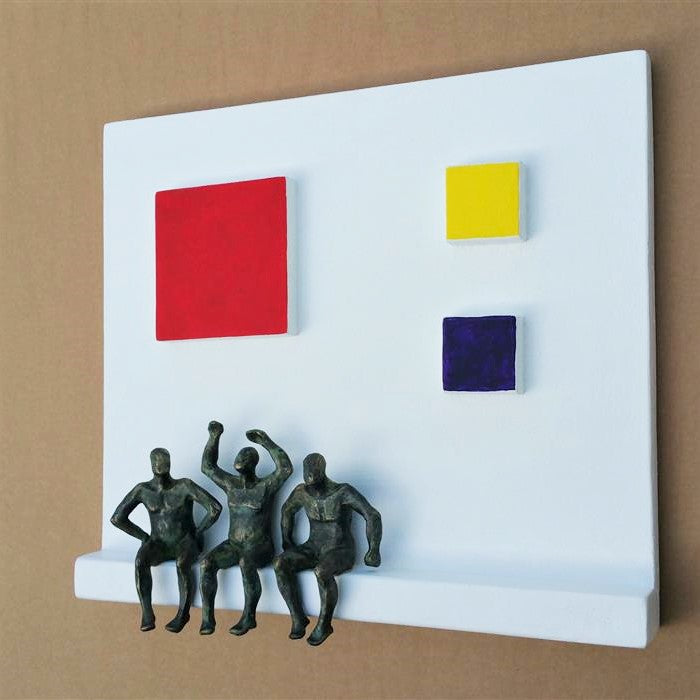How to Care for Your Sculpture Art



A friend recently shared how he and his wife fell in love with a small sculpture they discovered while on a trip out of town. They initially passed on it but then couldn't get it out of their heads and later reached out to the artist, who worked with them to come up with the perfect commissioned piece. They told us how they found the ideal spot in their home to showcase the bronze sculpture, and how the original work brings them daily joy.
While sculptures aren't purchased as frequently as oil paintings and other art to hang on your wall, the three-dimensional medium can make a powerful statement as part of a well-curated and meaningful art collection within your home. However, because they aren't the most commonly purchased artworks, many art consumers aren't sure how to care for and clean their sculptural pieces.
As part of our series about how to care for your art, we're zeroing in on your personally owned sculptures and sharing what we've learned in researching how to care for them. As with other types of art we've discussed, proper care can go a long way toward preserving these valuable pieces for a lifetime and beyond.
Common Types of Sculptures
To share the most meaningful tips, it's helpful to review the different materials artists commonly use to create sculptures. Although the list is vast, some of the most typical materials used for modern-day sculptures include stone, wood, bronze, and other metals, and ceramics such as clay. These all require preventative care though like the other mediums we've discussed, cleaning and care are not a one-size-fits-all approach.
Caring for Stone Sculptures
While stone is hardly a delicate medium, it does present some unique challenges for care and cleaning. In fact, experts in the conservation field advise that stone sculptures shouldn't be cleaned, or for that matter handled, on a regular basis. Along with frequent touching, cleaning can cause accelerated deterioration.
With this in mind, cleaning your fine art stone sculptures might be best left to the professionals, such as a conservator, whose approach will usually involve the gentle application of a brush and water. If you do attempt at-home care, keep in mind that stone sculptures should never be cleaned with detergents or products containing chemicals.
Caring for Wooden Sculpture
While we wouldn't call them delicate, wooden sculptures are more susceptible to the elements than some sculptural art. With this in mind, you'll want to use care for both your indoor and outdoor wooden sculptures. If displaying a wood sculpture outdoors, it may reduce the lifespan for which your artwork will be in prime condition, but there are ways to help preserve its quality.
Dryness is the enemy of wooden art in that it can cause dulling over time. Avoid direct sunlight when displaying or storing your wooden sculptures. Also keep in mind that cracking can be a natural long-term effect with some forms of wood sculptures but can be mitigated with preventative care, such as a stain or varnish that soaks into the pores of the sculpture. These types of treatments vary depending on where you are displaying your artwork, so you will want to conduct research specific to your piece when determining the best approach. As part of your initial purchase, find out exactly what materials the artist used in terms of any preventative treatments, and what they recommend for ongoing care.
In general, as it relates to your indoor wooden sculptures, you should be able to use a dry rag or a common dusting brush to keep your wooden sculpture clean. If that won't suffice due to a more substantial-build up of dirt and dust, you can purchase non-toxic wood cleaners, reading the instructions carefully to ensure the products are safe for art.
Caring for Metal Sculptures
On a scale of 1 to indestructible, metal sculptures rank well for their durability, so much so that they are a common choice for outdoor art displays and public artwork. Whether we're talking about large-scale public exhibits or smaller pieces that are part of your personal collection, the care and cleaning process is fairly consistent among metal sculptures.
This can be as simple as a damp cloth for removing superficial dirt and dust or utilizing a polishing treatment. We receive lots of questions about bronze sculptures, which require minimal maintenance if kept indoors and can be cleaned using a gentle soap such as an Ivory dishwashing detergent and water combination applied with a soft cloth.
If you're displaying your bronze sculptures outdoors, the bronze should have a surface coating such as a protective wax application to mitigate the hazards of exposure to humidity and moisture. You should consider replenishing a wax coating annually, although initial consultation with the artist is recommended for ensuring the safest treatments.
Caring for Ceramic Sculptures
Clay and other types of ceramic sculptures are more fragile than some of the other mediums we've discussed, so general handling should be done with care. However, these materials are a bit more user-friendly when it comes to cleaning, and less vulnerable to environmental conditions that may be concerns with many other artworks.
As a general rule, use latex gloves if you are required to pick up or move your sculpture. As for cleaning, experts recommend lightly dusting your ceramic sculptures with a gentle brush, avoiding wool or cotton which can catch on the sculpture's surface. For more thorough cleaning, a gentle dish soap and water combination works well, being extremely careful so as not to cause chips or cracks.
Final Thoughts
If you're like us, your original artworks are among your most treasured assets. As with all our advice about caring for your artwork, when in doubt, consult a professional.
If you're in the market to add to your collection of original works, you can peruse the latest works by talented artists on our website, which is refreshed and updated with new art weekly.





